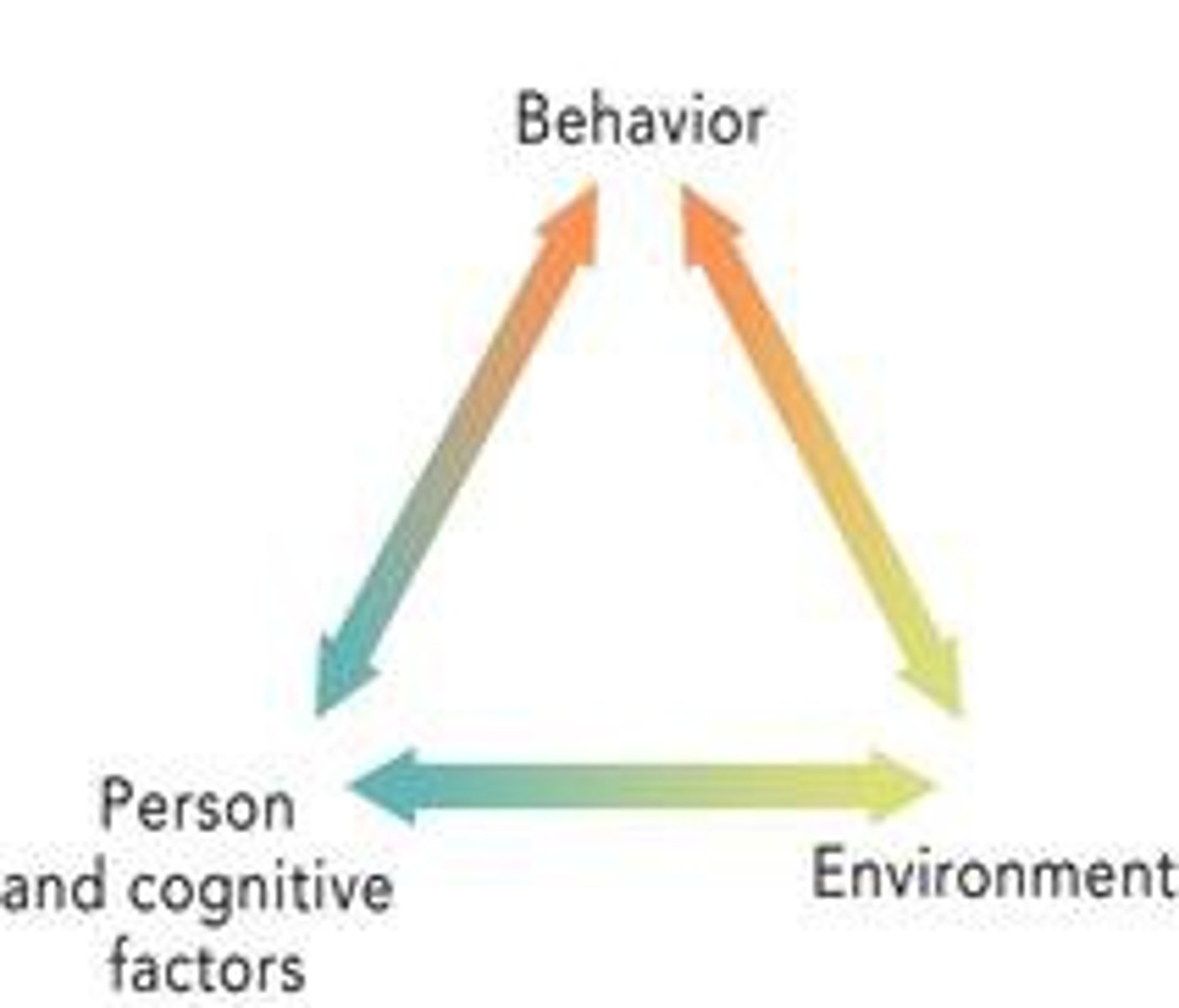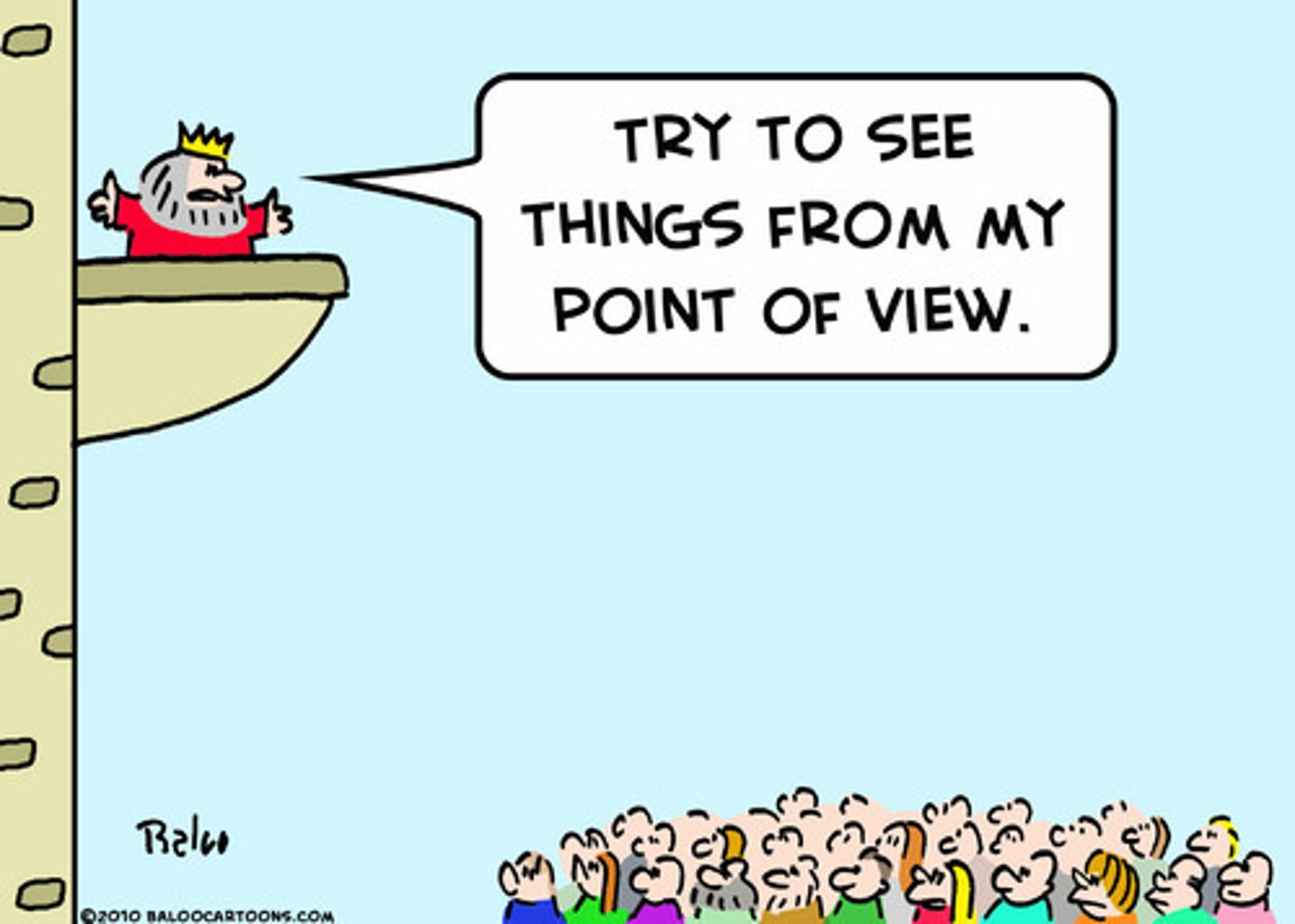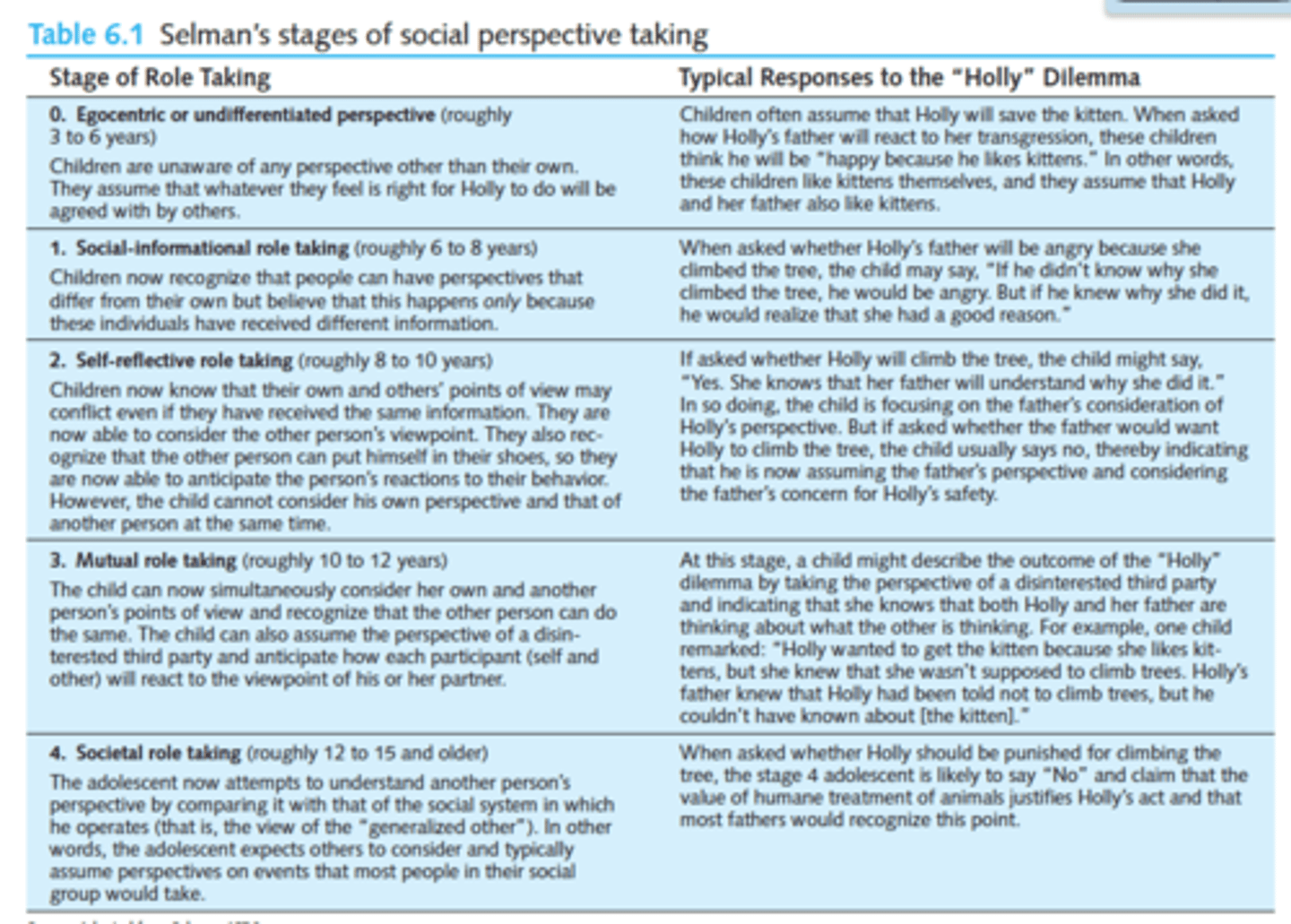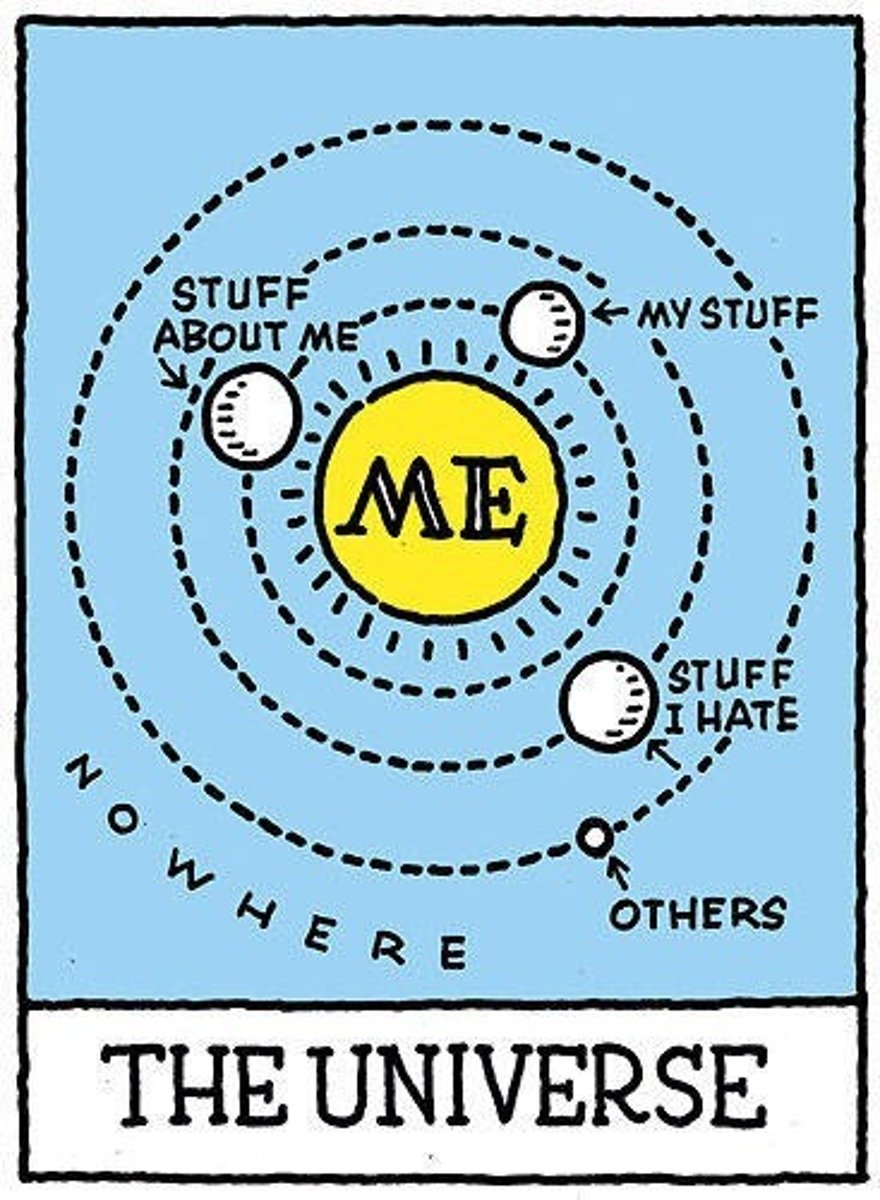Social Cognition
1/28
There's no tags or description
Looks like no tags are added yet.
Name | Mastery | Learn | Test | Matching | Spaced |
|---|
No study sessions yet.
29 Terms
Social Cognition
Selman's theory of perspective taking
= the mental processes we go through, the processes we make when we are engaged in a social interaction
... what we understand about a social situation AND the decisions we make as a result, are cognitive processes

How do we make decisions?
...we often make decisions on how to behave based on our understanding of a social situation
Perspective Taking
= our ability to appreciate a social situation from the perspective of other people
... this cognitive ability to understand the view point of others, underlies much of our normal social interaction

Robert Selman
... an American-born educational psychologist and perspective taking theorist
=> specialises in adolescent social development
Physical Perspective Taking
Physically understanding what someone else can see
i.e. 3 mountain task, egocentrism - Piaget

Social Perspective Taking
Understanding other people's thoughts/feelings/emotions

Piaget vs Selman
PIAGET took a physical and social perspective taking approach
... happen together, at the same time, and occur hand in hand
(Domain GENERAL approach)
SELMAN took a Domain SPECIFIC approach
...social perspective taking is a separate processes, and develops independently to physical perspective
Selman's Perspective Taking
... gave children scenarios along with a question that required them to take the perspective of others
=> Based on their answers, he developed a stage theory to explain the way in which children develop their ability to take different perspectives
Selman's proposed 5 stages
He proposed 5 stages:
o Undifferentiated perspective taking
o Social-informational perspective taking
o Self-reflective perspective taking
o Mutual perspective taking
o Societal perspective taking

Selman's Perspective Taking Study Procedure
- 30 boys and 30 girls
- 20 of them aged 4, 20 of them aged 5, 20 of them aged 6
- Were asked how people felt in each scenario
Selman's Perspective Taking Study HOLLY SCENARIO
Holly Scenario
Holly has promised her father she will never climb trees again. one day, after school on her way home, Holly spots her friend, who's new kitten is stuck up a tree
Outcome A = Holly doesn't climb the tree to save the kitten
Outcome B = Holly climbs the trees and saves the kitten
Consider and describe the feelings of each person involved in this scenario

Selman's Perspective Taking Study FINDINGS
- A number of distinct levels of role-taking were identified
- Selman found the level of role taking correlated with age
- This suggested a clear development sequence
Undifferentiated Perspective Taking (STAGE 0)
AGE 3-6
children recognise different emotions of themselves and others but not the reasons behind it and FREQUENTLY CONFUSE the two emotions
Response: child recognises that Holly's friend is sad that Holly doesn't climb the tree, but not why, and can recognise that Holly's father would be made if Holly climbed the tree, but no why he would be mad t
SOCIALLY EGOCENTRIC

Social Informational Perspective Taking (STAGE 1)
AGE 6-8
recognise the difference between their own and someone else's perspective, but only one at a time
SOCIAL INFORMATIONAL ROLE TAKING
Self-Reflective Perspective Taking (STAGE 2)
AGE 8-10
children can "step into another person's shoes" and view their own thoughts, feelings, and behaviour from the other persons perspective
... also recognise that others can do the same
can understand why someone feels a certain way, but only one at a time again
SELF-REFLECTIVE ROLE TAKING

Third Person Perspective/Mutual Role Taking (STAGE 3)
AGE 10-12
children can step outside a 1 person situation and imagine how the self and other's POVs are viewed from an IMPARTIAL third party
...this response steps outside the immediate situation to view both Holly's and her father's perspective simultaneously
children can take other's perspective at the same time as they're own, and understand the reasons why
MUTUAL ROLE TAKING
Societal Perspective Taking (STAGE 4)
AGE 12+
individuals understand that 3rd party perspective taking can be influenced by one or more systems of larger societal value
understand that being able to take others perspectives is sometimes not enough
... as children mature they take more info into account, allow them to see different POVs of same situation
+
can analyse the perspectives of several people involved from objective bystander view
+
can understand the influence of different cultural/social values
SOCIAL & CONVENTIONAL SYSTEM ROLE TAKING
Socially egocentric
= undifferentiated perspective taking
Social informational role taking
= social informational perspective taking
Self reflective role taking
= Self reflective perspective taking
Mutual role taking
= Third party perspective taking
Social and Conventional System role taking
= Societal perspective taking
Later developments Schultz, Selman and La Russo (2003)
3 more aspects of social development
1. Interpersonal understanding
2. Interpersonal negotiation strategies
3. Awareness of personal meaning of relationships
Interpersonal understanding
children want to be able to take different perspectives and roles as this is the motivates us to understand the social situation and develop
Interpersonal negotiation strategies
further understanding of social situation can allow us to respond accordingly
e.g., managing conflict, empathy in a situation
Awareness of personal meaning of relationships
The ability to reflect on social behaviour in the context of life history and the full range of relationships
i.e., knowledge about position in society and roles that people take, and how the environment can influence a situation
A03 STRENGTH - validity
P
A strength of Selman's theory is that he provided solid evidence that perspective taking improves with age.
EX
Within his research, positive correlations were found between age and ability to take different perspectives in scenarios.
EV
In the Holly-Kitten study, those aged 12 and above responded with a far more complex and holistic answer that accounted for multiple perspectives when compared to the children aged 3-6.
EX
Longitudinal studies with similar scenarios produced similar responses and this suggests that Selman's original research was not a case of individual differences.
EXT
Another strength of Selman's theory is its value and application in conflict resolution and family therapies. Perspective taking has been used to reduce aggression levels by getting individuals to emphasise with other people's feelings and viewpoints.
LB
This shows how Selman's theory has a practical application and is supported by insightful research that took place over a considerable period of time, increasing its internal validity.
A03 STRENGTH - highly controlled
P
Additionally, Selman's perspective taking theory was based around research that used standardised, rigorous methods of testing.
EV
When conducting his interviews and research, he used a good sample size of 60 with even numbers of mixed genders, good range of ages from 3-15, and high levels of control were applied as participants were given identical scenarios and asked identical questions.
EX
This reduced any gender bias, produced rich-in depth data, and increased the internal validity of the research.
EXT
Furthermore, Selman's theory and research into the range of perspectives appears to be important in understanding atypical development, particularly with children diagnosed with ADHD or on the autistic spectrum. Marton et al. (2009) compared 80 8-12-year-olds with ADHD to a control group on their performance on perspective taking. Those with ADHD did worse on understanding the scenarios, identifying the feelings of each person involved and evaluating the consequences of different action.
LB
The shows the practical value of Selman's research, as well as giving support and credibility to his theory.
A03 WEAKNESS - limited explanation
P
However, a limitation of Selman's approach is that it is entirely based on an understanding of cognition.
EX
Perspective taking is a cognitive ability but there is more to children's social development than their cognitive abilities, suggesting that Selman's view is overly cognitive and restricted.
EV
Internal factors such as emotional self-regulation and empathy or external factors like family climate, opportunities to learn from observations and peer interaction could all influence a person's perspective taking abilities, all of which are not acknowledged by Selman's approach.
EXT
As well as this, Fitzgerald and White (2003) found a link between parenting style and perspective taking which contradicts Selman's theory. They conducted a study with 93 school-aged children and found a significant correlation between the parenting style that used victim centred discipline and perspective taking. The socio-economic status of the household was also related to the pattern of relationships between perspective taking, social behaviour, and VCD.
LB
This emphasises how social and environmental factors can influence a child's perspective taking, suggesting Selman's approach is limited.